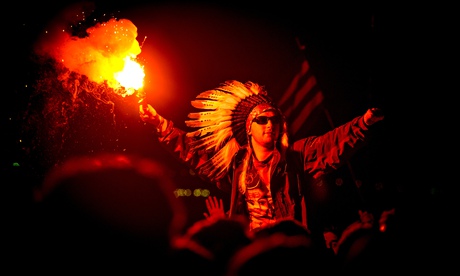Organizers of the B.C. music festival say they're overwhelmed by the international reaction
The feathered headdress has become a sensitive pop culture phenomenon, springing up in fashion shows, music videos and on the heads of partygoers from Coachella to Bonnaroo.
But in a statement posted last week on Facebook, Bass Coast organizers explained that headdresses are unwelcome at this weekend's festival, which takes place on indigenous territory, and that security would be enforcing the ban.
Paul Brooks, the festival's communications manager, told CBC Arts reporter Zulekha Nathoo that the ban is about respect:
"This has been an ongoing topic of debate within electronic music and within festivals and our core team felt it was time to take a stand," he said.
By Andrea Crossan
A real headdress has slightly more impressive plumage. “Mostly these are eagle feathers, and eagle feathers are almost invariably treated as being very sacred objects,” says Daniel Justice, professor of First Nations Studies at the University of British Columbia. He's also a member of the Cherokee Nation.
Headdresses are traditionally worn by a community member who's been honored as a leader, so Justice says having any old concertgoer sport one, especially a low-quality replica, is a serious insult.
"It's a pretty big slap in the face," he says. "But it's also part of a much longer and much more egregious history of colonial appropriation of indigenous things that are significant—trivializing them, repurposing them for really banal and sometimes really offensive purposes.”

Approaching a tipping point?
This means war: why the fashion headdress must be stopped
The Native American headdress is a common sight at festivals. It has also been appropriated by fashion brands and stars such as Pharrell Williams. But many are now fighting back against what they see as a crude act of racial stereotyping
By Dorian Lynskey
The backlash is a classic example of online activism. It has not been spearheaded by an official campaign, lobby group or celebrity spokesperson but a growing array of individual voices repeatedly making one simple demand: stop wearing headdresses as fashion accessories. Many of those making this demand, however, are surprised that it even needs to be said in 2014.
"When it first started happening, my reaction was like, really?" says Ehren Thomas, also known as Bear Witness, of the Ottawa-based dance music trio A Tribe Called Red. "I thought we were over this. I thought the politically correct age of the 90s had taught people we weren't allowed to make fun of other cultures but apparently I was wrong."
This summer, headdresses, often accessorised with fluoro warpaint, have been ubiquitous at festivals from Coachella to Latitude. Festival culture has always been drawn to the idea of tribes: consider the neo-pagan aesthetic of Burning Man, the early 90s free-party scene and the hardcore hippie enclaves of Glastonbury. Put people in a field for a weekend, sleeping under canvas (and, in some cases, teepees), possibly on drugs, and some are bound to explore fantasies of escaping modern society and embracing their "natural" selves via the otherness of older cultures. Headdresses slot comfortably into the amorphous array of "tribal" knickknacks that have been keeping festival stall-holders in business for years.
But the case against headdress chic is powerful, and it's threefold. First, the trend ignores the differences between indigenous peoples. There are 564 federally recognised tribes in the US alone, but fashion smushes them into one vague stereotype with all the sophistication of a B-grade 1950s western. "You'll see someone wearing a headdress in the same picture as a totem pole and a canoe when actually those are from three different cultures," says Bear Witness. "The totem poles are from the northwest, headdresses are from the plains and the kind of canoes you usually see are woodland canoes. So it's robbing us of our individual cultures."
By Drew Hayden Taylor
I can understand this position, not for the usual socio-political reasons cited, but simply because wanting to wear these things as a fashion statement is stupid, with the exception of my grandfather of course. It’s not honouring anything or anybody except the “look at me, I look so cool” Nation, which is far too populous a tribe.
For one thing, I am sure this fascination is tied into the mythological power and glory of the Prairie Indians. Getting sunburned at a folk festival is so strikingly similar to hunting buffalo. Everybody wants to be Lakota, which is fine. If you’re Lakota. This also includes the Bloods, Peigans, Plains Cree and other assorted and legitimate wearers of headdresses. I don’t exactly see a rush of people in the mosh pits wearing the Iroquois gustoweh or a traditional Salish woven cedar hat. I don’t think they are considered as cool, which is odd considering that in the Native community, the Iroquois and Salish are regarded as quite cool.
The same principle applies to native people regarding the wearing of culturally unsuitable attire. It’s rare you’ll find a Cree man snowmobiling in a Kilt. Or a Mi’qmak lounging around in lederhosen. Or a Dene rocking on in a turban. There’s just not much point.
With the campaigns against Indian headdresses and mascots, people are finally starting to think about how they stereotype Natives. I'm not sure we're near a tipping point yet; we probably still have a long way to go. But in a few decades, we may reach the point we've already reached with blacks. Namely, that portraying them as savages or subhumans is wrong--even if people keep doing it.
P.S. There are 566 federally recognized tribes, not 564.


No comments:
Post a Comment
Note: Only a member of this blog may post a comment.